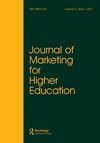Predicting Chinese students’ destination choice intentions for international higher education in post-COVID-19: combining the image-value-behavior framework and protection motivation theory
IF 2.1
3区 管理学
Q3 BUSINESS
引用次数: 0
Abstract
ABSTRACTDespite the dramatic changes COVID-19 brought to international higher education (IHE), studies investigating students’ destination choices for IHE from a pandemic perspective are limited. This study introduces an integrated model combining the destination image-perceived value-behavioral intention framework and protection motivation theory, which includes both promotion and prevention factors and captures students’ destination images regarding COVID-19, to examine factors influencing their destination choices for IHE purposes in the post-COVID-19 era. This study set China as the context, as it is the largest source country in the IHE sector. Data was collected from Chinese university students (N = 346) who were considering studying abroad. Using PLS-based structural equation modeling techniques, the results show that destination image, as a multi-dimensional construct, can be regarded as an important antecedent towards perceived risk, trust in government, and self-efficacy; destination image, trust in government, and self-efficacy positively influence perceived value; and there is a positive relationship between perceived value and destination choice intention. This study provides insights for host governments and educational providers that desire to attract more Chinese students and can help the recovery of IHE after the pandemic.KEYWORDS: International higher educationChinese studentsdestination imageprotection motivation theorydestination choice intentionCOVID-19 pandemic Disclosure statementNo potential conflict of interest was reported by the author(s).Additional informationFundingThis work was supported by Chris Ryan’s Academician Workstation in Hainan Province. The Education Department of Hainan Province [Hnkyzc2023-4]. The specific research fund of The Innovation Platform for Academicians of Hainan Province. Research Project of Educational and Teaching Reform in Higher Education Institutions of Hainan Province [HDJY2233].新冠肺炎疫情后中国留学生留学目的地选择意愿预测:结合形象-价值-行为框架与保护动机理论
摘要尽管新冠肺炎疫情给国际高等教育带来了巨大的变化,但从大流行视角考察学生留学目的地选择的研究仍然有限。本研究引入目的地形象-感知价值-行为意向框架和保护动机理论相结合的综合模型,包括促进因素和预防因素,并捕获学生关于COVID-19的目的地形象,以研究后COVID-19时代影响学生IHE目的目的地选择的因素。本研究以中国为背景,因为中国是高等教育行业最大的来源国。数据收集自346名考虑出国留学的中国大学生。利用基于pls的结构方程建模技术,研究结果表明,目的地形象作为一个多维结构,可以被认为是感知风险、政府信任和自我效能感的重要前因变量;目的地形象、政府信任和自我效能正向影响感知价值;感知价值与目的地选择意愿之间存在正相关关系。这项研究为希望吸引更多中国学生的东道国政府和教育机构提供了见解,并有助于疫情后IHE的恢复。关键词:国际高等教育中国学生目的地形象保护动机理论目的地选择意向covid -19大流行披露声明作者未报告潜在利益冲突。本研究得到了海南省Chris Ryan院士工作站的支持。海南省教育厅[Hnkyzc2023-4]。海南省院士创新平台专项科研经费。海南省高等学校教育教学改革研究项目[HDJY2233]。
本文章由计算机程序翻译,如有差异,请以英文原文为准。
求助全文
约1分钟内获得全文
求助全文
来源期刊
CiteScore
7.80
自引率
42.40%
发文量
37
期刊介绍:
The Journal of Marketing for Higher Education is a well-established, double-blind peer reviewed, international journal that publishes original research and review articles. It has been publishing articles on higher education marketing since 1988 and is international in outlook with a readership and papers from across the world. The Journal of Marketing for Higher Education is a multi-disciplinary journal and welcomes papers from all the major disciplines that connect with the marketing of higher education.

 求助内容:
求助内容: 应助结果提醒方式:
应助结果提醒方式:


